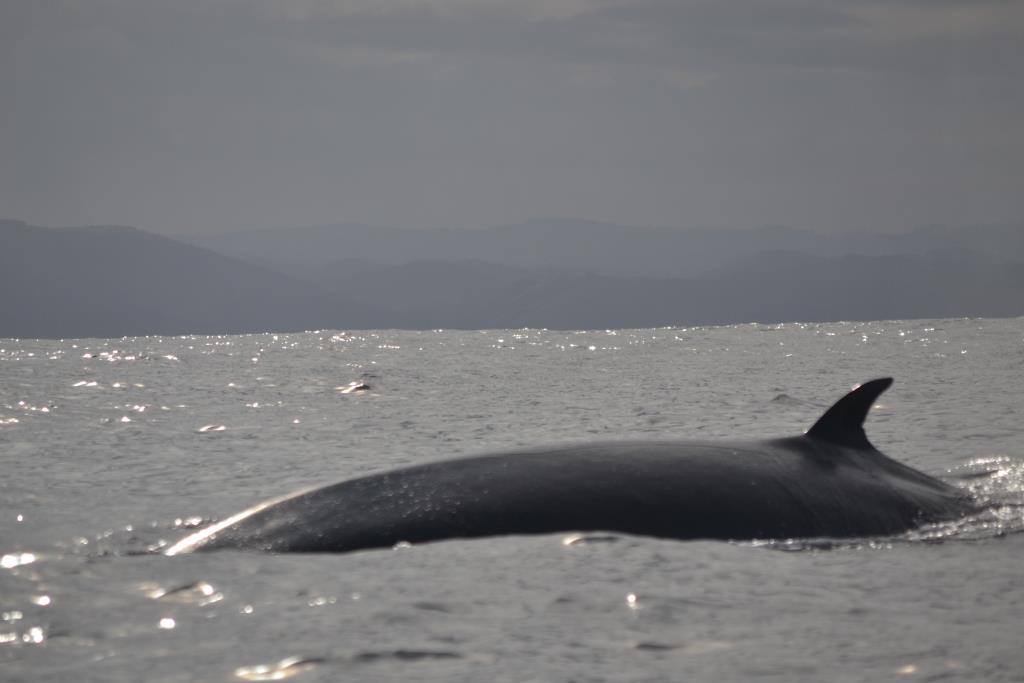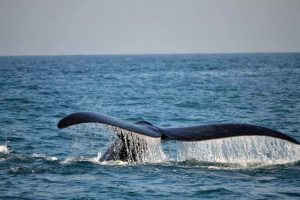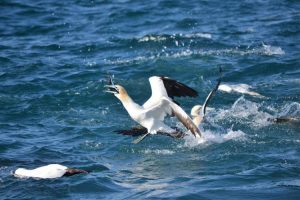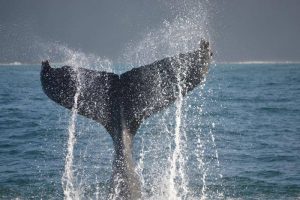As promised, here is another part in our series of ocean sightings along our coastline.
The famous Bryde’s whale.
The Bryde’s whale is, simply put, a superb predator with a rather comical name given to it during the annual sardine run. That being “the stealth mode” whale.
There are many stories at the end of a busy and action packed sardine run ocean day, where the Bryde’s whale has paid divers/snorkelers a visit and the story will start off with something along the lines of … “this Bryde’s whale just appeared out of nowhere”, or “I narrowly missed being swallowed as I saw this large mouth swallow the entire ball of sardines”, or “I saw this shadow appear and it became a whale, in stealth mode, just swallowing all the sardines”, or “I was literally shoved out of the way by this shadow that appeared out of nowhere and mouth open, swallowed all the sardines” and so the stories will go over a few drinks in the evening.
Some interesting facts about the Bryde’s whale:-
- It is a small to medium-sized baleen whale
- There are 2 forms of Bryde’s whales in the South African sub region. An inshore, smaller and an offshore, migratory, larger
- Recent research suggests that the inshore population is probably less than 1000 animals
- The offshore Bryde’s whale is different to the inshore Bryde’s whale by the presence of oval scars all over the body, caused by the cookie cutter shark.
- Bryde’s whales have 3 longitudinal ridges on the upper surface of the top jaw that distinguish it from other similar looking species.
- The upper surfaces of the body and head and the outer surface of the flipper are bluish black, becoming paler on the sides of the body towards a whitish belly.
- The Bryde’s whale gets its’ name from John Bryde, an entrepreneur and businessman from the Norwegians who was responsible for setting up whaling ports designed to capture whales and sell their oil, blubber and other parts for money during the whaling era
- In terms of size, Bryde’s whale males tend to be slightly smaller than their females i.e. 15m (female) and 14.5m (male). The inshore Bryde’s whale is smaller at 14m (female) and 13m (males). Weight is max 20 tons although the inshore Bryde’s whale weight is likely to be around 15 tons.
- They have slender bodies, narrow pectoral fins and the ventral throat grooves extend as far as the navel.
- While searching for food these whales can dive underwater for up to 20 minutes before resurfacing for air
- Being part of the baleen whale suborder, Bryde’s whales do not possess teeth but are equipped with baleen plates that have bristles attached to them to allow the whale to filter prey from the water
WHAT DO THEY EAT you may ask?
The two populations off South Africa appear to have different diets. The offshore population feeds on both krill and offshore fish and the inshore population feeds on small pelagic shoaling fish such as anchovies, sardine and massbankers. Unlike other members of this group, the inshore population of Bryde’s whale is found close to the coast and feeds in relatively shallow water, often in association with other species such as common dolphins, cape gannets and Cape fur seals. They are often found in areas that have abundant supplies of fish and other prey. They capture their food by looking for large shoals or gatherings of potential prey and then swim through them and engulf whatever is available. Talk about being one to upset a party???? Just when you are watching the most amazing bait ball of sardines and the camera is out and ready to film, the Bryde’s whale has been known to blast in from nowhere and gobble the entire shoal right in front of disbelieving eyes!!!
They have also been spotted hunting and stealing prey that other marine animals have worked hard to herd together and obtain.
WHERE DO THEY SPEND MOST OF THEIR TIME AND WHERE DO THEY GO TO?
The inshore Bryde’s whale is resident over the Agulhas Banks and is commonly encountered in bays along the south-east coast, especially in the autumn months. Its distribution seems to be concentrated between East London on the east coast and False Bay in the west, with only occasional sightings beyond this range.
The offshore Bryde’s whale occurs along the west coast of Southern Africa in waters beyond the continental shelf i.e. 400m depth contour. The SE Atlantic population is thought to move as far north as Gabon and then south to about 40 deg S.
HOW DO THEY COMMUNICATE & HOW SOCIAL ARE THEY?
They are often found travelling either alone or in smaller groups of between 2-4 whales.
They are largely solitary but can be found in smaller groups during feeding and mating periods but there is no evidence of an organized social structure.
Unlike other species of baleen whales, Bryde’s whales tend to move in irregular patterns both surfacing and changing direction for no particular reason, making their patterns unpredictable and unusual. They do not appear to dive to any great depth.
Little is known about how they communicate but it IS known that, like other species within the baleen family, Bryde’s whales communicate using low-frequency sounds which often resemble the sound of someone moaning. In some cases the sounds may come in short bursts which last less than half a second, while others are longer and more drawn out. Many people ask what the meaning is of their communication calls. While some facts are unknown, their calls are most likely used to communicate desire to mate, to alert others of nearby danger, to find other members of a group or pod or to let others know of nearby food among other survival based communication.
WHAT IS THEIR LIFESPAN & REPRODUCTION
The average gestation period for the Bryde’s whale is approximately 11-12 months.
The South African inshore Bryde’s whale is polyestrous (has more than one period of estrus per year and calves have been recorded throughout the year in coastal waters. The offshore Bryde’s whale has an extended breeding season i.e. not clearly defined like in migratory baleen whales such as humpback & southern right whales), that spans the austral spring and summer.
When first born, they measure an average of 3-4 metres in length. After birth, the female will nurse her calf for 6-12 months or until the newborn is able to hunt and survive on its own.
Sexual maturity for the Bryde’s whale is between 7-14 years, at which point they reach their matured size and may begin mating and bearing offspring of their own.
There is not enough information about their lifespan.
WHAT ARE THEIR THREATS?
This species has not been hunted as intensively as the other baleen whales, but as the populations appear to be localized, the effect of relatively small catches on each population may be considerable. In past years these whales were caught off West Africa, Brazil, South Africa, particularly on the west coast and in Japanese waters and around the Bonin Islands. Small numbers have also been taken off West Australia and around New Zealand and Japanese catches resumed in the North Pacific in 2000 under “scientific permit” for up to 50 whales per annum.
VIEWING BRYDE’S WHALES
The inshore Bryde’s whales can be viewed year round along the South African coastline, with the highest encounter rate reported from the coast east coast in the autumn months. They are commonly encountered during the Sardine Run. The offshore Bryde’s whales can be viewed in offshore waters of the west coast of South Africa in summer.
IUCN STATUS
Offshore Bryde’s whales – insufficient data
Inshore Bryde’s whales – vulnerable
Get in touch with us https://offshoreportstjohns.com/contact/
Special thanks to Seafari marine mammal tracking Bryde’s whale sightings for the extra information on these spectacular whales.




